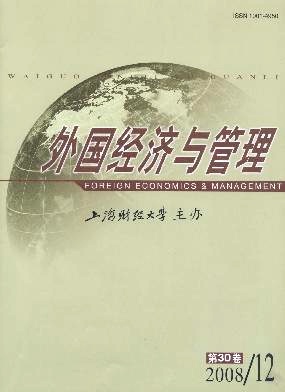气氛研究的范式界定与脉络梳理
外国经济与管理 2008 年 第 30 卷第 12 期, 页码:25 - 31
摘要
参考文献
摘要
尽管学者们的气氛研究兴趣日益高涨,但是,气氛研究饱受概念界定和在不同分析层次上的准确测量这两个难以处理但又相关的难题的困扰,因而导致研究思路非常混乱。本文根据空间和时间这两条线索对气氛研究的现有文献进行了梳理,并把因循空间线索的气氛研究范式分为六种,又因循时间线索把气氛研究阶段分为相互并非完全独立而是彼此重叠和交叉的四个阶段,并详细介绍了这四个阶段的气氛研究特点,最后对气氛研究的不足进行了总结。
[1]Neil R Anderson,and Michael A West.Measuring cli mate for work groupinnovation:Development and validation of the teamcli mate inventory[J].Journal of Organizational Behavior,1998,19:235-258.
[2]Christopher P Parker,et al.Relationships between psychological cli mate perceptions and work outcomes:A meta-analytic review[J].Journal of Organizational Behavior,2003,24(4):389-407.
[3]Litwin,G,and Stringer,R.Motivation and organizational cli mate[M].Boston:Harvard Business School Press,1968.
[4]Ittleson,W H,Proshansky,H M,Rivlin,L G,and Winkel,G H.Introduction to environmental psychology[M].New York:Holt,Rinehart,and Winston,1974.
[5]Jones,L R,and James,AP.Organizational cli mate:Areviewof theory and research[J].Psychological Bulletin,1974,81:1096-1112.
[6]Lawrence RJames,and Alan Hart man.Relationships between psychological cli mate and a VIE model for work motivation[J].Per-sonnel Psychology,1997,30:229-254.
[7]Schneider,B.Organizational cli mates:An essay[J].Personnel Psychology,1975,28:447-479.
[8]Jones,A P,and James,L R.Psychological cli mate:Di mensions and relationship of individual and aggregated work environment per-ceptions[J].Organizational Behavior and Human Performance,1979,23:201-250.
[9]Hellriegel,Slocum.Organizational cli mate:Measures,research and contingencies[J].Academy of Management Journal,1974,17(2):255-267.
[10]Chan,D.Functional relations among constructsin the same content domain at different levels of analysis:Atypology of composition models[J].Journal of Applied Psychology,1998,83:234-246.
[11]James,L R.Aggregation bias in esti mates of perceptual agreement[J].Journal of Applied Psychology,1982,67:219-229.
[12]Denison,Daniel R.What is the difference between organizational culture and organizational cli mate?A native’s point of view on a decade of paradigm wars[J].The Academy of Management Review,1996,21(3):619-654.
[13]Schneider,B,and Reichere,A E.On the etiology of cli mates[J].Personnel Psychology,1983,36:19-39.
[14]Ashforth,B E.Cli mate formation:Issues and extensions[J].Academy of Management Review,1985,10:837-847.
[15]Rousseau,D M.The construction of cli matein organizational research[A].in C Cooper,and I Robertson(Eds.).International re-viewof industrial and organizational psychology[C].New York:Wiley,1988:139-158.
[16]E E Kossek,and S C Zonia.Assessing diversity cli mate:Afield study of reactions to employer efforts to promote diversity[J].Jour-nal of Organizational Behavior,1993,14:61-81.
[17]Ekvall,G.Organizational cli mate for creativity andinnovation[J].European Journal of Work&Organizational Psychology,1996,5(1):105-123.
[18]Flin,R,Mearns,K,O’Connor,P,and Bryden,R.Measuring safety cli mate:Identifyingthe commonfeatures[J].Safety Science,2000,34,177-192.
[19]Rouiller,Janice Z,and Goldstein,Irwin L.The relationship between organizational transfer cli mate and positive transfer of training[J].Human Resource Development Quarterly,1993,4(4):377-390.
[20]Joyce,WF,and Slocum,J W,Jr.Collective cli mate:Agreement as a basis for defining aggregate cli mates in organizations[J].A-cademy of Management Journal,1984,27:721-742.
[2]Christopher P Parker,et al.Relationships between psychological cli mate perceptions and work outcomes:A meta-analytic review[J].Journal of Organizational Behavior,2003,24(4):389-407.
[3]Litwin,G,and Stringer,R.Motivation and organizational cli mate[M].Boston:Harvard Business School Press,1968.
[4]Ittleson,W H,Proshansky,H M,Rivlin,L G,and Winkel,G H.Introduction to environmental psychology[M].New York:Holt,Rinehart,and Winston,1974.
[5]Jones,L R,and James,AP.Organizational cli mate:Areviewof theory and research[J].Psychological Bulletin,1974,81:1096-1112.
[6]Lawrence RJames,and Alan Hart man.Relationships between psychological cli mate and a VIE model for work motivation[J].Per-sonnel Psychology,1997,30:229-254.
[7]Schneider,B.Organizational cli mates:An essay[J].Personnel Psychology,1975,28:447-479.
[8]Jones,A P,and James,L R.Psychological cli mate:Di mensions and relationship of individual and aggregated work environment per-ceptions[J].Organizational Behavior and Human Performance,1979,23:201-250.
[9]Hellriegel,Slocum.Organizational cli mate:Measures,research and contingencies[J].Academy of Management Journal,1974,17(2):255-267.
[10]Chan,D.Functional relations among constructsin the same content domain at different levels of analysis:Atypology of composition models[J].Journal of Applied Psychology,1998,83:234-246.
[11]James,L R.Aggregation bias in esti mates of perceptual agreement[J].Journal of Applied Psychology,1982,67:219-229.
[12]Denison,Daniel R.What is the difference between organizational culture and organizational cli mate?A native’s point of view on a decade of paradigm wars[J].The Academy of Management Review,1996,21(3):619-654.
[13]Schneider,B,and Reichere,A E.On the etiology of cli mates[J].Personnel Psychology,1983,36:19-39.
[14]Ashforth,B E.Cli mate formation:Issues and extensions[J].Academy of Management Review,1985,10:837-847.
[15]Rousseau,D M.The construction of cli matein organizational research[A].in C Cooper,and I Robertson(Eds.).International re-viewof industrial and organizational psychology[C].New York:Wiley,1988:139-158.
[16]E E Kossek,and S C Zonia.Assessing diversity cli mate:Afield study of reactions to employer efforts to promote diversity[J].Jour-nal of Organizational Behavior,1993,14:61-81.
[17]Ekvall,G.Organizational cli mate for creativity andinnovation[J].European Journal of Work&Organizational Psychology,1996,5(1):105-123.
[18]Flin,R,Mearns,K,O’Connor,P,and Bryden,R.Measuring safety cli mate:Identifyingthe commonfeatures[J].Safety Science,2000,34,177-192.
[19]Rouiller,Janice Z,and Goldstein,Irwin L.The relationship between organizational transfer cli mate and positive transfer of training[J].Human Resource Development Quarterly,1993,4(4):377-390.
[20]Joyce,WF,and Slocum,J W,Jr.Collective cli mate:Agreement as a basis for defining aggregate cli mates in organizations[J].A-cademy of Management Journal,1984,27:721-742.
引用本文
刘云, 石金涛. 气氛研究的范式界定与脉络梳理[J]. 外国经济与管理, 2008, 30(12): 25–31.
导出参考文献,格式为:
上一篇:组织理论认知观评介
下一篇:品牌国际化研究述评





 7729
7729  189
189

